Although thousands of boat smoothhound are caught by UK sea anglers during the course of an average summer, beating the 20lb barrier remains one of the hardest weights to achieve in modern sea angling.
You can get lucky, of course, and bag one of these monsters wherever you fish, but certain areas seem to throw up significantly better numbers of these heavyweights and it makes sense to give yourself the very best chance by fishing a known hotspot. It’s the old adage, “Right place, right time”. One such port is Holyhead in North Wales.
Gethyn Owen, who skippers My Way 2, an Offshore 105, has seen more than his fair share of 20lb smoothhound over the gunwales in the past 20-years or so. Gethyn, a Welsh international boat angler turned skipper, seems to have the knack of finding these huge fish pretty much every season, which incidentally, runs from May to August off Holyhead. In 2007 the Welsh Record was broken aboard My Way by Wigan based angler, Brian Taylor. Brian broke the Welsh Record by over 2lbs with a fish that bounced the scales at 25lbs 6oz. This remains the current boat caught Welsh Record for a starry smoothhound and is comparable to the UK record, which stands at 28lbs 2oz taken off Minehead in 1998 by A Bowring.
But that doesn’t tell the whole story. Since then there are scores of 20lb plus fish that have graced the decks of Gethyn’s original My Way, and his new boat, My Way 2. Several fish larger than the current records have also been returned without official weighing, the concern is to conserve the fish. It’s only a matter of time before one of these fish tops 30lbs, but for now, 20lbs is the Holy Grail.
Despite fishing classic ports in Essex, Hampshire, others both sides of the Bristol Channel, and witnessing the excellent smoothhound fishing off Wicklow in Ireland, the best I’d so far recorded was a little shy of 18lbs. Close, but not close enough! Even during two or three days out with Geth each summer prior to 2016, the best I’d had was a 16lber. But I was taking mental notes, having conversations with Geth, and slowly but surely piecing together a basic strategy that might help me get into the “oh so hard” 20lb club.
Mike Jr and I were booked aboard My Way for two days, the 9th and 10th of June, 2016. The tides were falling towards neaps. Wednesday 9th being a 28.9ft tide and the Thursday falling quickly to 27.5ft. High water was at 14.15 and 15.10 respectively. Weather conditions were good. Warm and sunny with variable winds on the Wednesday, but with more cloud evident on the Thursday. The latter being my preferred conditions.
What I’ve found in these clearer sunnier conditions is that the fish can be very on edge, often picking up and dropping baits. Sometimes they come back, sometimes they don’t. This is how it was on the Wednesday. The boat crew as a whole were missing bite after bite and though I changed to a shorter and shorter hook length and to a lighter breaking strain of Fluorocarbon, which did improve my hook up ratio a little, I was still missing a lot of bites. I had seven smoothhound that day, the best 9lbs and worked hard for every one of them.
Overnight, I had a rethink regards my tackle set up. For the Thursday I changed my Fluorocarbon hook link from 40 to 30lbs. I also dropped down to a smaller hook in the shape of a Mustad Viking 79515 4/0. My intention was to use a smaller bait to make it easier for the fish to take the bait fully in, also for the bait to present more naturally. During the day, I would also constantly change my lead weight to one just large enough to hold bottom, no heavier. The idea was, given the angle of the line entering the water being quite steep due to depth, to get the weight to lift up in the water as a fish moved the bait in and to try and induce a self-hooking effect. Results were not spectacular and though prior to high water and a move for other species I’d caught four smoothies to 7lbs, I’d still missed bites, though to be fair, the numbers of fish were less with the smaller tide. The other lads had faired much the same, though there were two better smoothhound caught just into double figures.
The decision was made to move elsewhere and have an hour or so over high water on general species, then move back to the original mark and the smoothhound for the first hour of the ebb before heading straight back to port. There were three small smoothies caught pretty much straight away, but as the ebb picked up the bites died to nothing. If you take note when fishing for smoothhound, they tend to come in waves, a few fish being caught, then a period of no bites, then more action. It’s in these periods of inactivity that I feel the bigger lone fish move in to feed. They don’t want to compete with the smaller, faster more nimble fish. They want the ground to themselves and take their time. That’s how they grow big.
My preferred tackle for smoothhound is an 11ft Shakespeare Tipster rod which has a very soft, supple tip for increased sensitivity and enhanced bite detection. The extra length allows you to cast away from the boat a fair distance and search more ground for feeding hotspots. I match this to a Penn Spinfisher 5500 reel loaded with 30lb braid and a 30lb fluorocarbon leader. I like the clear leader as it gives a visual separation between the tackle and the braid, it adds just a hint of a stretch when you’re playing a big fish on a short line close to the boat, plus it is abrasion resistant and protects the braid from both the seabed and smoothhound body contact. The ability to cast away from the boat would become key.
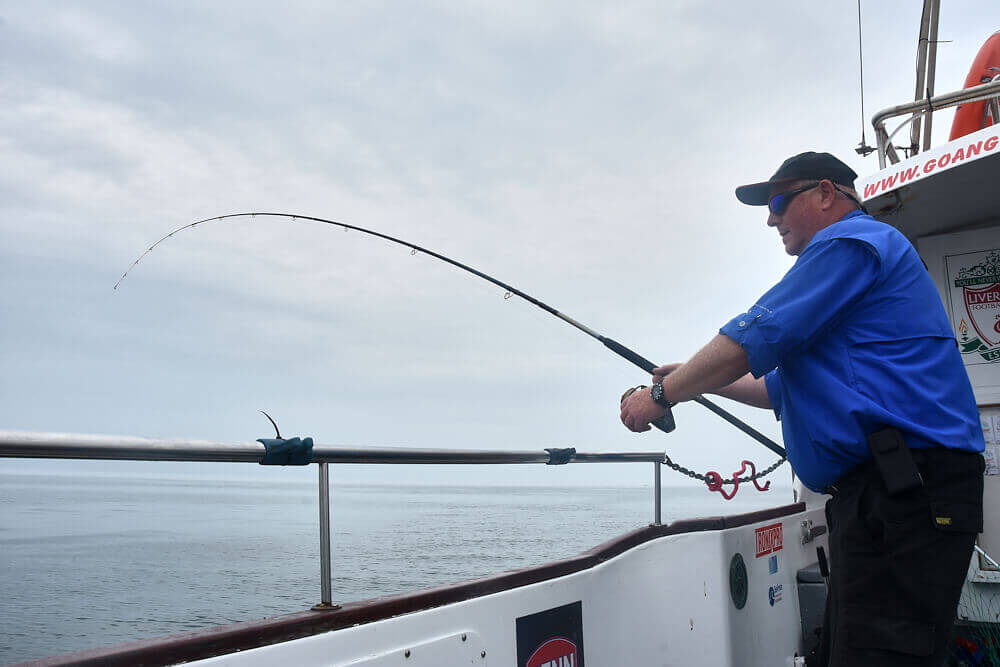
I chose a crab about the size of a 50p piece, fed the body over the hook then tied the legs from one side up over the hook shank with bait elastic to disguise the hook and force any smoothhound to take the bait from the hook point end. I was on the starboard stern corner, so I was able to cast the bait well away from the other lads putting my bait out on its own, which is where I wanted it.
Geth had already called time and some of the lads had already reeled in, but I always leave it to the very last minute before reeling in. Watching the rod tip, I saw it tap and tap again, then nothing happened. I was unsure but left the rod alone. Slowly the tip pulled down and I lifted into a weight that felt at first like I was snagged. Then the snag moved! The fish did not initially power off, but it kited first downtide away from me, then swung to the left. I knew it was a big fish and eased off the drag just a touch. The fish then swam uptide coming parallel with the boat, kicked, then ripped line off as it turned and bored off downtide again. It came up in the water column a little. I could feel it twisting and turning. Then it dived and I felt the fish clip the seabed. It ran off to the right, but by now all the other lads’ rods were out of the water. It took more line and was a fair way behind the boat now, but still not far off the seabed.
I started to work the fish, pumping it up inches at a time. If it wanted line, it took it, but equally, when it didn’t, I worked it and gained more line than I was giving. It was mid water now and then somebody said they could see colour, but it went down one more time and had to be worked back bit by bit. Eventually, colour was there again and Gethyn, by now next to me, net in hand, said “It’s a big fish!” That made me even more careful and I edged off the drag pressure just a little more using just my finger on the spool to control the fish. Suddenly it surfaced, but all I saw was the net dipped in a flash and a grimace on Geth’s face as he lifted it aboard. It was obviously over 20lbs.
I asked Gethyn to weigh the fish in his purpose made sling and I waited while others watched until Geth said, 23lbs 3ozs. It was as accurate as possible due to the flat calm sea and no swell and we took the lowest weight. It had been a long wait, a long learning curve, but a memory that will last a lifetime. The last I saw of the fish was as it slid out of the net and powered for the deep.
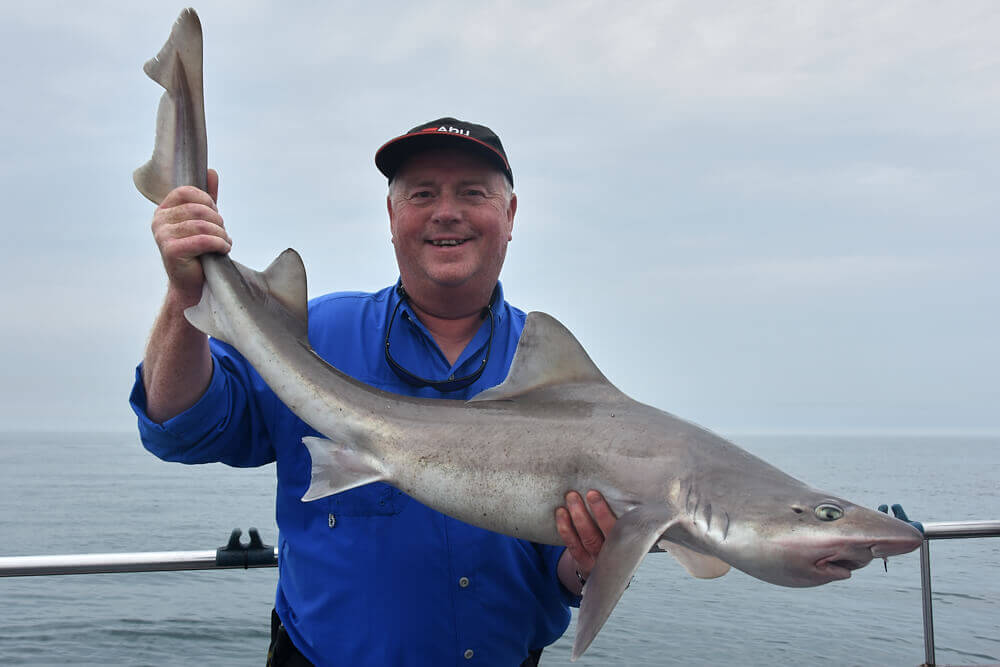 23lb 3oz Smoothhound for Mike Thrussell
23lb 3oz Smoothhound for Mike Thrussell
Over the past five years, I’ve been lucky enough to capture two hounds over 20lbs. Each year a trip is organised with Mike Senior, Jim Midgley, Dave Barham, Elton Murphy and myself where we head over to Holyhead for a couple of days smoothhound fishing with Gethyn...and a few customary pints of Guinness! Sadly neither Elton nor Dave could join us on this occasion.
By mid-morning, I’d already caught a couple of fish, an 8lber and one that was close to 12lbs. I was fishing light with a 9ft Shakespeare Agility Tipster rod and a small 5000 fixed spool loaded with braid. With a correctly set drag and the right playing technique, these rods are super fun when fishing for the bigger hounds.
With the two smoothhound already on the board, I cast out a small crab bait from the stern, adjusting the drag so the fish could take line when it struck and placed the rod into the holder. I noticed almost immediately a slight tap on the rod, I picked the rod up and felt for more. The fish had been quite finicky all day so instead of rushing things, I let the bite develop. A second tap followed, again I left this alone. On the third tap, a savage take emerged and I leant into the fish. The response was a solid thud and moments later the braid was screaming off the reel. The fish ran for about ten yards, stopped and then hung in the water.
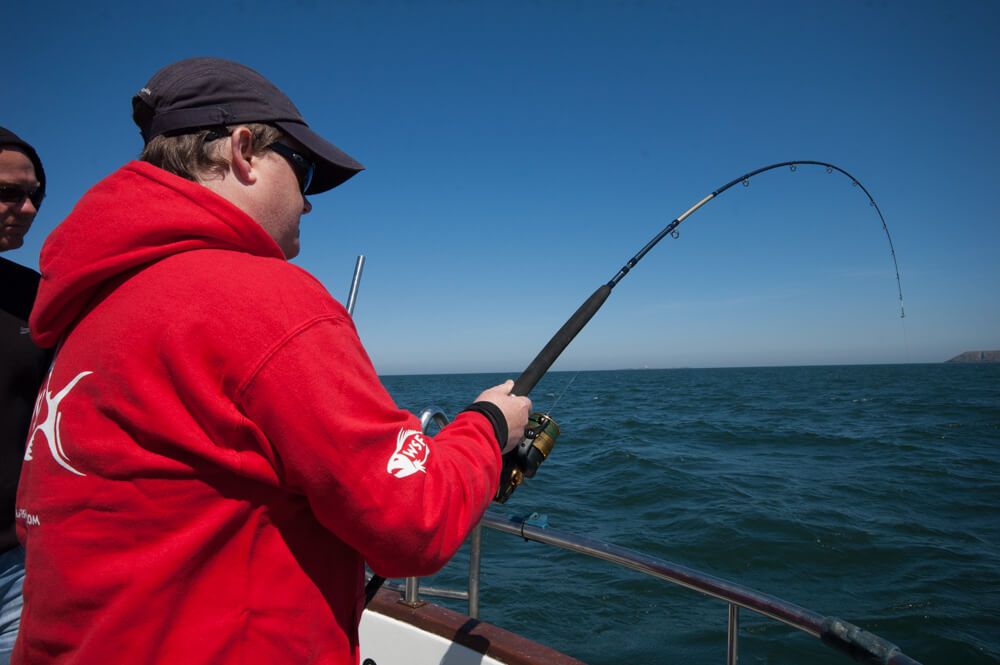
Moments later, the smoothhound went on a sudden, long-run culminating in another pause and then I felt the head start to nod, the fish had gone deep and wasn’t keen on moving. Applying pressure, trying to force it to move, it eventually relented and started to move up through the water. Every few turns of the reel, she protested and tried to head deeper again. Gone were the long runs, now it was doggedly trying to keep its depth. After a while, the fish started to tire and I began to settle in, bringing the fish up slowly but consistently, the butt of the rod doing the work for me as the fish began to move towards the surface and the waiting net.
After some time the fish was at the surface, it was clearly a big smoothhound, Jim was taking photographs as the fish was brought to the surface and immediately called it as a near twenty as she breached the surface. It wasn’t long before the fish was in the net and as Gethyn lifted it, he also noted that this could be a twenty. An anxious few moments followed while Gethyn prepared his weight sling and zeroed in his certified scales. After what seemed like an age a fish over 20lbs was secured, with the lowest weight taken.
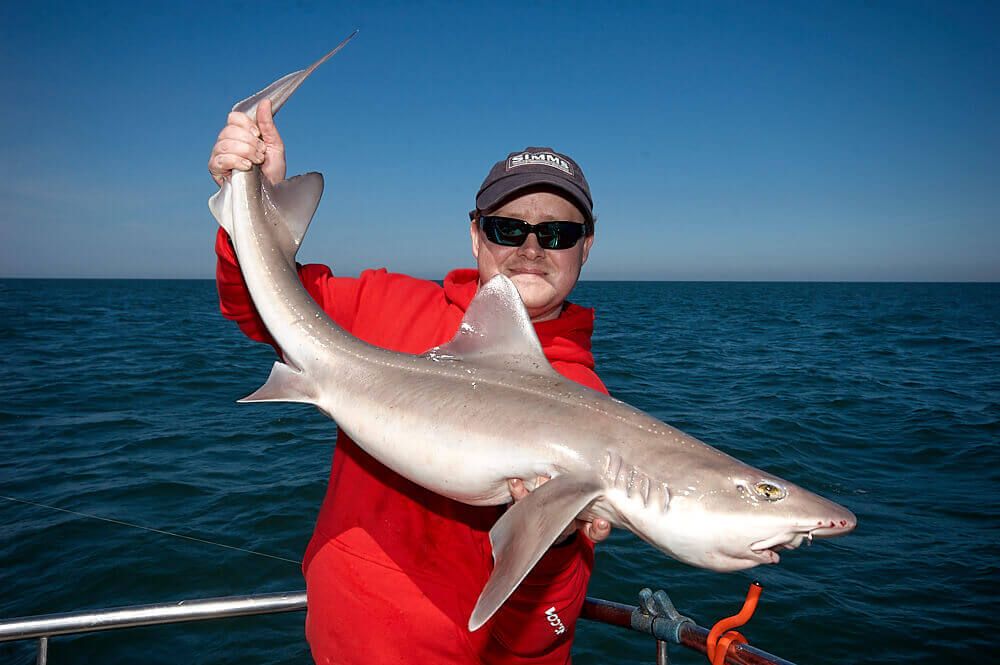 Mike Thrussell Jnr with his first 20+ Smoothhound
Mike Thrussell Jnr with his first 20+ Smoothhound
My second twenty came the following summer. For those of you who follow me on social media, you’ll know I like a bit of carp fishing. The person responsible for this is a good mate of mine, Paul Craig from Somerset. We were fishing in France the year before and on one of our long, late-night chats about fish and fishing, he mentioned he fancied giving sea fishing a go and asked if we could sort something out. A quick call to Gethyn the next day and My Way was secured for a day's hound fishing in early June 2016.
The trip was nestled in between one of the hottest periods of the year so far. The previous two days Paul and I had been fishing for carp at a local water, with temperatures inside our bivvies bordering on the ridiculous. Our day afloat was no different, with temperatures on the day reaching nearly 40c on deck!
For this trip, I’d got my hands on a couple of new rods from the HTO lures range. I’d got with me the HTO Shore Game, an out and out bass lure rod and the first version of the HTO Lure Game. Both of these rods are exceptional lure fishing rods, but they have plenty of poke to be used as light tackle rods for smoothhound fishing. I’d also recently invested in a set of 4000 size Shimano Baitrunners, which paired up well with the two lure rods and also gave me the free spool option to allow the hounds to run while keeping the main drag set.
The day started slowly with very little action in the morning, after lunch, it settled and we got stuck into some consistent fishing. Geth was the first into the fish with several hounds in quick succession up to 10lbs. There were only four of us on board so we were all fishing with a couple of rods each. I’d decided at the start of the day to fish one rod away from the boat with the second rod fishing directly under the boat.
The smoothhound seemed in a strange mood and although we’d had over a dozen fish between us, we’d dropped as many, with tentative, shy bites that would continue all day.
The temperature soared while an ominous-looking, deep, dark cloud gathered to the east. The atmosphere became more and more oppressive and it was clear that at some point, the beautiful day would descend into a downpour of major proportions, with a bit of thunder likely too.
As the weather began to close in I noticed a small knock on the bait that was placed under the boat, then another one. With the fish being so strange all day, I didn’t immediately leap into action, I just waited to see what would happen. A couple of minutes went by with no sign of movement and then the tip suddenly whipped over and the baitrunner began paying out line. A dogged, plod from a fish that possibly didn’t even know it was hooked yet.
I calmly picked up the rod and flicked the baitrunner switch to the off position and gently lifted into the fish, this provoked a response as the fish changed from thoughtful plodding mode to all-out assault. The smoothhound took a good twenty yards of line and then stopped, hung deep and prepared itself for a long drawn out fight. Similar to my previous twenty plus fish, this one was almost a carbon copy of the fight of the previous. Keeping its head down waiting to see who would tire first.
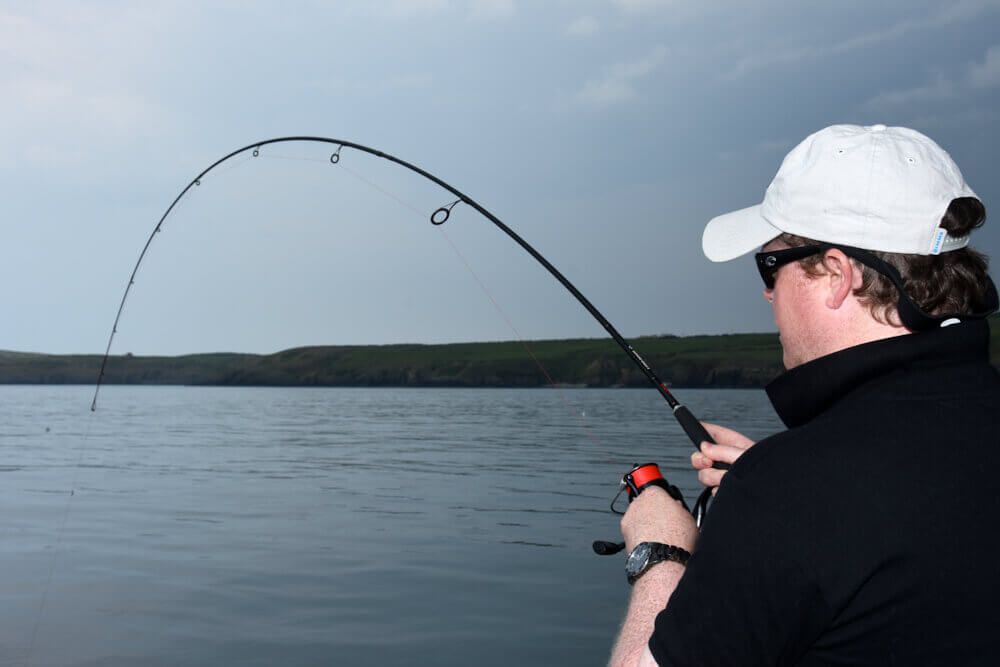
The Lure Game Mk1 has a surprising amount of power in the butt section and with short, slow pumps of the rod, I was able to gain line gently and cautiously made progress on the fish. Geth by this point had realised it was a decent-sized smoothhound and had already wound in his rods and had the net ready.
I’d got the fish close to the surface and hoping we’d be able to get it aboard quickly and with no fuss, it had other ideas. Taking a look at the net, it decided it didn’t like the look of it and buried its head and charged for the bottom. I had little room to manoeuvre so let it do what it needed to do, knowing that shortly I’d be able to make headway once more. When the run was over the fish hung deep again, I started to work the rod with short pumps and bring it back towards the surface. Eventually, the smoothhound was at the surface ready for the waiting net, Geth seamlessly drew the net under the fish and lifted it aboard.
It was clearly a big fish and as Geth went to prepare the weigh sling and grab his scales those ominous clouds from the east positioned themselves directly above us and the heavens opened. What had been a flat calm, tranquil day turned into large rain droplets bouncing off the deck and sea surface and within a matter of moments, we were all drenched. It mattered little, we had a big hound to weight, photograph and gently return.
With the scales zeroed and the fish in the sling, we lifted her up and clipped the sling into the scale hook, once again the digital scales recorded the lowest weight over 20lbs and it was another twenty-pound smoothhound in the bag. She sat perfectly still for a couple of photos and once they were done I lifted her over the gunwale and was released back into the sea. As soon as her nose hit the water she was off, a strong, confident wag of her tail and she was headed for home.
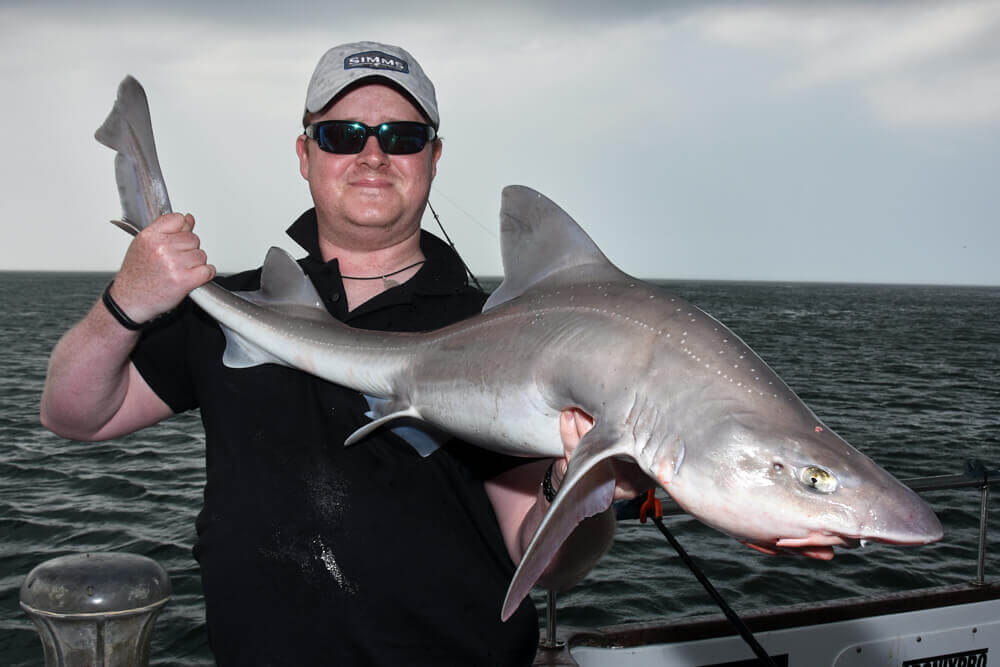 Mike Thrussell Jnr with his second 20lb+ smoothhound.
Mike Thrussell Jnr with his second 20lb+ smoothhound.
One of the key things when handling smoothhounds, and especially the bigger fish which can conceivably be females in pup, is to support their weight at all times. This starts at the boat side prior to landing. The best skippers have a large landing net available and will net and lift all sizable smoothhound. It also helps if someone throws a bucket of water on the deck area where the fish will be unhooked just so there is no heat exchange from the deck to the fish if it's sunny.
Unhook the fish as fast as possible. Use gentle force to hold the fish still while the camera is prepared. Putting fresh cold seawater over the fish via a bucket helps keep the fish in tip-top condition for the few seconds this takes.
An open sling is the only way to weigh a smoothhound or any big fish. Zero the scale to the empty sling. Place the fish in the swing, ensure its pectoral fins are not unduly bent, close the sling and lift the fish. Most honest anglers take the lowest weight given.
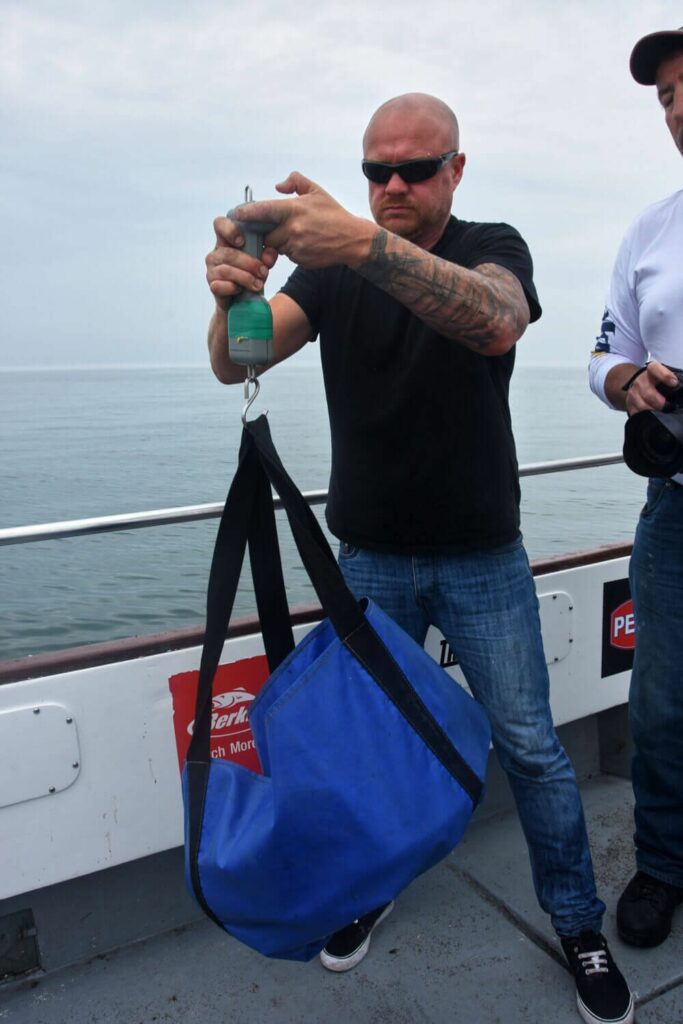 Use a weigh sling to weight all hounds.
Use a weigh sling to weight all hounds.
When lifting and holding a smoothhound for the camera, get a good grip around the wrist of the tail, with the other hand under the forward belly either by the pectoral fins or just in front of them. Now lift the fish with the tail slightly up and the head down. At all times be prepared for the fish to squirm. With a firm grip even big fish are controllable, but if it moves and you’re unsure of your grip, put the fish down and start again. If the sea is unsettled, then back yourself into a corner and put your legs and backside up against the gunwale for added support. Always choose the side of the boat facing away from the sun for the best light and to avoid exposure issues. This applies to phone cameras as well as DSLR’s.
The best way to return a smoothhound is to hold it as described and if you have access via a marlin door, you can just slip the fish back from your hands. If you have to lift fish over the gunwale, the best way is to place it back in the net, then into the water and manoeuvre the net to let the fish swim free. Try to do this with the fish’s head facing into the tide.
You can get lucky, of course, and bag one of these monsters wherever you fish, but certain areas seem to throw up significantly better numbers of these heavyweights and it makes sense to give yourself the very best chance by fishing a known hotspot. It’s the old adage, “Right place, right time”. One such port is Holyhead in North Wales.
Gethyn Owen, who skippers My Way 2, an Offshore 105, has seen more than his fair share of 20lb smoothhound over the gunwales in the past 20-years or so. Gethyn, a Welsh international boat angler turned skipper, seems to have the knack of finding these huge fish pretty much every season, which incidentally, runs from May to August off Holyhead. In 2007 the Welsh Record was broken aboard My Way by Wigan based angler, Brian Taylor. Brian broke the Welsh Record by over 2lbs with a fish that bounced the scales at 25lbs 6oz. This remains the current boat caught Welsh Record for a starry smoothhound and is comparable to the UK record, which stands at 28lbs 2oz taken off Minehead in 1998 by A Bowring.
But that doesn’t tell the whole story. Since then there are scores of 20lb plus fish that have graced the decks of Gethyn’s original My Way, and his new boat, My Way 2. Several fish larger than the current records have also been returned without official weighing, the concern is to conserve the fish. It’s only a matter of time before one of these fish tops 30lbs, but for now, 20lbs is the Holy Grail.
A First Twenty for Mike Senior
Despite fishing classic ports in Essex, Hampshire, others both sides of the Bristol Channel, and witnessing the excellent smoothhound fishing off Wicklow in Ireland, the best I’d so far recorded was a little shy of 18lbs. Close, but not close enough! Even during two or three days out with Geth each summer prior to 2016, the best I’d had was a 16lber. But I was taking mental notes, having conversations with Geth, and slowly but surely piecing together a basic strategy that might help me get into the “oh so hard” 20lb club.
Mike Jr and I were booked aboard My Way for two days, the 9th and 10th of June, 2016. The tides were falling towards neaps. Wednesday 9th being a 28.9ft tide and the Thursday falling quickly to 27.5ft. High water was at 14.15 and 15.10 respectively. Weather conditions were good. Warm and sunny with variable winds on the Wednesday, but with more cloud evident on the Thursday. The latter being my preferred conditions.
What I’ve found in these clearer sunnier conditions is that the fish can be very on edge, often picking up and dropping baits. Sometimes they come back, sometimes they don’t. This is how it was on the Wednesday. The boat crew as a whole were missing bite after bite and though I changed to a shorter and shorter hook length and to a lighter breaking strain of Fluorocarbon, which did improve my hook up ratio a little, I was still missing a lot of bites. I had seven smoothhound that day, the best 9lbs and worked hard for every one of them.
Overnight, I had a rethink regards my tackle set up. For the Thursday I changed my Fluorocarbon hook link from 40 to 30lbs. I also dropped down to a smaller hook in the shape of a Mustad Viking 79515 4/0. My intention was to use a smaller bait to make it easier for the fish to take the bait fully in, also for the bait to present more naturally. During the day, I would also constantly change my lead weight to one just large enough to hold bottom, no heavier. The idea was, given the angle of the line entering the water being quite steep due to depth, to get the weight to lift up in the water as a fish moved the bait in and to try and induce a self-hooking effect. Results were not spectacular and though prior to high water and a move for other species I’d caught four smoothies to 7lbs, I’d still missed bites, though to be fair, the numbers of fish were less with the smaller tide. The other lads had faired much the same, though there were two better smoothhound caught just into double figures.
The decision was made to move elsewhere and have an hour or so over high water on general species, then move back to the original mark and the smoothhound for the first hour of the ebb before heading straight back to port. There were three small smoothies caught pretty much straight away, but as the ebb picked up the bites died to nothing. If you take note when fishing for smoothhound, they tend to come in waves, a few fish being caught, then a period of no bites, then more action. It’s in these periods of inactivity that I feel the bigger lone fish move in to feed. They don’t want to compete with the smaller, faster more nimble fish. They want the ground to themselves and take their time. That’s how they grow big.
My preferred tackle for smoothhound is an 11ft Shakespeare Tipster rod which has a very soft, supple tip for increased sensitivity and enhanced bite detection. The extra length allows you to cast away from the boat a fair distance and search more ground for feeding hotspots. I match this to a Penn Spinfisher 5500 reel loaded with 30lb braid and a 30lb fluorocarbon leader. I like the clear leader as it gives a visual separation between the tackle and the braid, it adds just a hint of a stretch when you’re playing a big fish on a short line close to the boat, plus it is abrasion resistant and protects the braid from both the seabed and smoothhound body contact. The ability to cast away from the boat would become key.

I chose a crab about the size of a 50p piece, fed the body over the hook then tied the legs from one side up over the hook shank with bait elastic to disguise the hook and force any smoothhound to take the bait from the hook point end. I was on the starboard stern corner, so I was able to cast the bait well away from the other lads putting my bait out on its own, which is where I wanted it.
Geth had already called time and some of the lads had already reeled in, but I always leave it to the very last minute before reeling in. Watching the rod tip, I saw it tap and tap again, then nothing happened. I was unsure but left the rod alone. Slowly the tip pulled down and I lifted into a weight that felt at first like I was snagged. Then the snag moved! The fish did not initially power off, but it kited first downtide away from me, then swung to the left. I knew it was a big fish and eased off the drag just a touch. The fish then swam uptide coming parallel with the boat, kicked, then ripped line off as it turned and bored off downtide again. It came up in the water column a little. I could feel it twisting and turning. Then it dived and I felt the fish clip the seabed. It ran off to the right, but by now all the other lads’ rods were out of the water. It took more line and was a fair way behind the boat now, but still not far off the seabed.
I started to work the fish, pumping it up inches at a time. If it wanted line, it took it, but equally, when it didn’t, I worked it and gained more line than I was giving. It was mid water now and then somebody said they could see colour, but it went down one more time and had to be worked back bit by bit. Eventually, colour was there again and Gethyn, by now next to me, net in hand, said “It’s a big fish!” That made me even more careful and I edged off the drag pressure just a little more using just my finger on the spool to control the fish. Suddenly it surfaced, but all I saw was the net dipped in a flash and a grimace on Geth’s face as he lifted it aboard. It was obviously over 20lbs.
I asked Gethyn to weigh the fish in his purpose made sling and I waited while others watched until Geth said, 23lbs 3ozs. It was as accurate as possible due to the flat calm sea and no swell and we took the lowest weight. It had been a long wait, a long learning curve, but a memory that will last a lifetime. The last I saw of the fish was as it slid out of the net and powered for the deep.

Two Twenties for Junior
Over the past five years, I’ve been lucky enough to capture two hounds over 20lbs. Each year a trip is organised with Mike Senior, Jim Midgley, Dave Barham, Elton Murphy and myself where we head over to Holyhead for a couple of days smoothhound fishing with Gethyn...and a few customary pints of Guinness! Sadly neither Elton nor Dave could join us on this occasion.
By mid-morning, I’d already caught a couple of fish, an 8lber and one that was close to 12lbs. I was fishing light with a 9ft Shakespeare Agility Tipster rod and a small 5000 fixed spool loaded with braid. With a correctly set drag and the right playing technique, these rods are super fun when fishing for the bigger hounds.
With the two smoothhound already on the board, I cast out a small crab bait from the stern, adjusting the drag so the fish could take line when it struck and placed the rod into the holder. I noticed almost immediately a slight tap on the rod, I picked the rod up and felt for more. The fish had been quite finicky all day so instead of rushing things, I let the bite develop. A second tap followed, again I left this alone. On the third tap, a savage take emerged and I leant into the fish. The response was a solid thud and moments later the braid was screaming off the reel. The fish ran for about ten yards, stopped and then hung in the water.

Moments later, the smoothhound went on a sudden, long-run culminating in another pause and then I felt the head start to nod, the fish had gone deep and wasn’t keen on moving. Applying pressure, trying to force it to move, it eventually relented and started to move up through the water. Every few turns of the reel, she protested and tried to head deeper again. Gone were the long runs, now it was doggedly trying to keep its depth. After a while, the fish started to tire and I began to settle in, bringing the fish up slowly but consistently, the butt of the rod doing the work for me as the fish began to move towards the surface and the waiting net.
After some time the fish was at the surface, it was clearly a big smoothhound, Jim was taking photographs as the fish was brought to the surface and immediately called it as a near twenty as she breached the surface. It wasn’t long before the fish was in the net and as Gethyn lifted it, he also noted that this could be a twenty. An anxious few moments followed while Gethyn prepared his weight sling and zeroed in his certified scales. After what seemed like an age a fish over 20lbs was secured, with the lowest weight taken.

My second twenty came the following summer. For those of you who follow me on social media, you’ll know I like a bit of carp fishing. The person responsible for this is a good mate of mine, Paul Craig from Somerset. We were fishing in France the year before and on one of our long, late-night chats about fish and fishing, he mentioned he fancied giving sea fishing a go and asked if we could sort something out. A quick call to Gethyn the next day and My Way was secured for a day's hound fishing in early June 2016.
The trip was nestled in between one of the hottest periods of the year so far. The previous two days Paul and I had been fishing for carp at a local water, with temperatures inside our bivvies bordering on the ridiculous. Our day afloat was no different, with temperatures on the day reaching nearly 40c on deck!
For this trip, I’d got my hands on a couple of new rods from the HTO lures range. I’d got with me the HTO Shore Game, an out and out bass lure rod and the first version of the HTO Lure Game. Both of these rods are exceptional lure fishing rods, but they have plenty of poke to be used as light tackle rods for smoothhound fishing. I’d also recently invested in a set of 4000 size Shimano Baitrunners, which paired up well with the two lure rods and also gave me the free spool option to allow the hounds to run while keeping the main drag set.
The day started slowly with very little action in the morning, after lunch, it settled and we got stuck into some consistent fishing. Geth was the first into the fish with several hounds in quick succession up to 10lbs. There were only four of us on board so we were all fishing with a couple of rods each. I’d decided at the start of the day to fish one rod away from the boat with the second rod fishing directly under the boat.
The smoothhound seemed in a strange mood and although we’d had over a dozen fish between us, we’d dropped as many, with tentative, shy bites that would continue all day.
The temperature soared while an ominous-looking, deep, dark cloud gathered to the east. The atmosphere became more and more oppressive and it was clear that at some point, the beautiful day would descend into a downpour of major proportions, with a bit of thunder likely too.
As the weather began to close in I noticed a small knock on the bait that was placed under the boat, then another one. With the fish being so strange all day, I didn’t immediately leap into action, I just waited to see what would happen. A couple of minutes went by with no sign of movement and then the tip suddenly whipped over and the baitrunner began paying out line. A dogged, plod from a fish that possibly didn’t even know it was hooked yet.
I calmly picked up the rod and flicked the baitrunner switch to the off position and gently lifted into the fish, this provoked a response as the fish changed from thoughtful plodding mode to all-out assault. The smoothhound took a good twenty yards of line and then stopped, hung deep and prepared itself for a long drawn out fight. Similar to my previous twenty plus fish, this one was almost a carbon copy of the fight of the previous. Keeping its head down waiting to see who would tire first.

The Lure Game Mk1 has a surprising amount of power in the butt section and with short, slow pumps of the rod, I was able to gain line gently and cautiously made progress on the fish. Geth by this point had realised it was a decent-sized smoothhound and had already wound in his rods and had the net ready.
I’d got the fish close to the surface and hoping we’d be able to get it aboard quickly and with no fuss, it had other ideas. Taking a look at the net, it decided it didn’t like the look of it and buried its head and charged for the bottom. I had little room to manoeuvre so let it do what it needed to do, knowing that shortly I’d be able to make headway once more. When the run was over the fish hung deep again, I started to work the rod with short pumps and bring it back towards the surface. Eventually, the smoothhound was at the surface ready for the waiting net, Geth seamlessly drew the net under the fish and lifted it aboard.
It was clearly a big fish and as Geth went to prepare the weigh sling and grab his scales those ominous clouds from the east positioned themselves directly above us and the heavens opened. What had been a flat calm, tranquil day turned into large rain droplets bouncing off the deck and sea surface and within a matter of moments, we were all drenched. It mattered little, we had a big hound to weight, photograph and gently return.
With the scales zeroed and the fish in the sling, we lifted her up and clipped the sling into the scale hook, once again the digital scales recorded the lowest weight over 20lbs and it was another twenty-pound smoothhound in the bag. She sat perfectly still for a couple of photos and once they were done I lifted her over the gunwale and was released back into the sea. As soon as her nose hit the water she was off, a strong, confident wag of her tail and she was headed for home.

Safety of big smoothhounds
One of the key things when handling smoothhounds, and especially the bigger fish which can conceivably be females in pup, is to support their weight at all times. This starts at the boat side prior to landing. The best skippers have a large landing net available and will net and lift all sizable smoothhound. It also helps if someone throws a bucket of water on the deck area where the fish will be unhooked just so there is no heat exchange from the deck to the fish if it's sunny.
Unhook the fish as fast as possible. Use gentle force to hold the fish still while the camera is prepared. Putting fresh cold seawater over the fish via a bucket helps keep the fish in tip-top condition for the few seconds this takes.
An open sling is the only way to weigh a smoothhound or any big fish. Zero the scale to the empty sling. Place the fish in the swing, ensure its pectoral fins are not unduly bent, close the sling and lift the fish. Most honest anglers take the lowest weight given.

When lifting and holding a smoothhound for the camera, get a good grip around the wrist of the tail, with the other hand under the forward belly either by the pectoral fins or just in front of them. Now lift the fish with the tail slightly up and the head down. At all times be prepared for the fish to squirm. With a firm grip even big fish are controllable, but if it moves and you’re unsure of your grip, put the fish down and start again. If the sea is unsettled, then back yourself into a corner and put your legs and backside up against the gunwale for added support. Always choose the side of the boat facing away from the sun for the best light and to avoid exposure issues. This applies to phone cameras as well as DSLR’s.
The best way to return a smoothhound is to hold it as described and if you have access via a marlin door, you can just slip the fish back from your hands. If you have to lift fish over the gunwale, the best way is to place it back in the net, then into the water and manoeuvre the net to let the fish swim free. Try to do this with the fish’s head facing into the tide.

